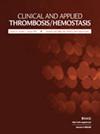Three-Year Outcomes, Risk Factors for Restenosis After Stenting for DVT Combined with Iliac Vein Compression Syndrome
IF 2.3
4区 医学
Q2 HEMATOLOGY
引用次数: 0
Abstract
This study aimed to evaluate the safety and efficacy of pharmacomechanical catheter-directed thrombolysis (PCDT) and stenting for treating acute iliofemoral deep venous thrombosis (DVT) combined with iliac vein compression syndrome (IVCS), and to identify the predictors of stent restenosis. Patients with acute proximal DVT combined with IVCS underwent PCDT and stenting from January 2017 to December 2022 were enrolled. Primary and secondary patency were assessed by duplex ultrasound (DUS). The morbidity of postthrombotic syndrome (PTS) was assessed by the Villalta score. Risk factors for stent restenosis were assessed using univariate and multivariate Cox regression models. Total of 254 patients were included. The mean follow-up time was 36.06 ± 17.66 months. The primary patency rates at 1 year, 3 years, and 5 years were 92.5%±1.7%, 85.4%±2.4%, and 82.4%±2.9%, respectively. The incidence of stent restenosis was 14.2%. Discontinuation of anticoagulants within one year [hazard ratio (HR) = 5.03; P = .048] was the factor associated with acute in-stent thrombosis. Previous DVT history (HR =2.29; P = .037) and stent placement across the inguinal ligament (HR =6.70; P < .001) were identified as independent risk factors significantly associated with stent restenosis. The overall PTS rate was 19.3%. PCDT with stenting is safe and effective for patients with iliofemoral DVT secondary to IVCS, leading to low rates of PTS. Previous DVT history and stents placed across the inguinal ligament may be predictors of stent restenosis. Furthermore, stent restenosis typically occurs within one year and is mainly caused by acute thrombosis due to discontinuation of anticoagulants.深静脉血栓合并髂静脉压迫综合征支架置入术后三年疗效及再狭窄的风险因素
本研究旨在评估药物机械导管引导溶栓(PCDT)和支架植入术治疗急性髂股深静脉血栓(DVT)合并髂静脉压迫综合征(IVCS)的安全性和有效性,并确定支架再狭窄的预测因素。2017年1月至2022年12月期间,急性近端深静脉血栓形成合并IVCS的患者接受了PCDT和支架植入术。通过双工超声(DUS)评估原发性和继发性通畅情况。血栓后综合征(PTS)的发病率通过 Villalta 评分进行评估。使用单变量和多变量 Cox 回归模型评估支架再狭窄的风险因素。共纳入 254 名患者。平均随访时间为(36.06 ± 17.66)个月。1年、3年和5年的主要通畅率分别为(92.5%±1.7%)、(85.4%±2.4%)和(82.4%±2.9%)。支架再狭窄的发生率为 14.2%。一年内停用抗凝药物[危险比(HR)=5.03;P = .048]是急性支架内血栓形成的相关因素。既往深静脉血栓病史(HR =2.29;P =0.037)和跨腹股沟韧带支架置入(HR =6.70;P <;0.001)被认为是与支架再狭窄显著相关的独立危险因素。PTS总发生率为19.3%。对于继发于 IVCS 的髂股深层静脉血栓患者来说,支架置入 PCDT 安全有效,PTS 发生率较低。既往深静脉血栓病史和横跨腹股沟韧带放置的支架可能是支架再狭窄的预测因素。此外,支架再狭窄通常发生在一年之内,主要是由于停用抗凝剂导致急性血栓形成。
本文章由计算机程序翻译,如有差异,请以英文原文为准。
求助全文
约1分钟内获得全文
求助全文
来源期刊
CiteScore
4.40
自引率
3.40%
发文量
150
审稿时长
2 months
期刊介绍:
CATH is a peer-reviewed bi-monthly journal that addresses the practical clinical and laboratory issues involved in managing bleeding and clotting disorders, especially those related to thrombosis, hemostasis, and vascular disorders. CATH covers clinical trials, studies on etiology, pathophysiology, diagnosis and treatment of thrombohemorrhagic disorders.

 求助内容:
求助内容: 应助结果提醒方式:
应助结果提醒方式:


